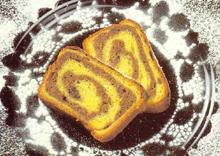
A croissant is a French pastry made from puff pastry in a crescent shape.

Hungarian or Magyar cuisine is the cuisine characteristic of the nation of Hungary, and its primary ethnic group, the Magyars. Hungarian cuisine has been described as being the spiciest cuisine in Europe. This can largely be attributed to the use of their piquant native spice, Hungarian paprika, in many of their dishes. A mild version of the spice, Hungarian sweet paprika, is commonly used as an alternative. Traditional Hungarian dishes are primarily based on meats, seasonal vegetables, fruits, bread, and dairy products.

A Gugelhupf (also Kugelhupf, Guglhupf, Gugelhopf, pronounced[ˈɡuːɡl̩.hʊp͡f,-hɔp͡f,ˈkuːɡl̩-], and, in France, kouglof, kougelhof, or kougelhopf, is a cake traditionally baked in a distinctive ring pan, similar to Bundt cake, but leavened with baker's yeast.

Prekmurska gibanica is a type of Slovenian gibanica or layered pastry. It contains poppy seeds, walnuts, apples, raisins and quark fillings. Although native to Prekmurje, it has achieved the status of a national specialty of Slovenia. The unique sweetmeat shows the variety of agriculture in this region. The name gibanica comes from the dialect expression güba and in this case refers to a fold.

Ukrainian cuisine is the collection of the various cooking traditions of the people of Ukraine, one of the largest and most populous European countries. It is heavily influenced by the rich dark soil (chornozem) from which its ingredients come, and often involves many components. Traditional Ukrainian dishes often experience a complex heating process – "at first they are fried or boiled, and then stewed or baked. This is the most distinctive feature of Ukrainian cuisine".

A strudel is a type of layered pastry with a filling that is usually sweet, but savoury fillings are also common. It became popular in the 18th century throughout the Habsburg Empire. Strudel is part of Austrian cuisine and German cuisine but is also common in other Central European cuisines. In Italy it is recognized as a traditional agri-food product (PAT) of South Tyrol.

Kifli, kiflice, kifle, or kipferl is a traditional yeast bread roll that is rolled and formed into a crescent before baking.

Slovak cuisine varies slightly from region to region across Slovakia. It was influenced by the traditional cuisine of its neighbours and it influenced them as well. The origins of traditional Slovak cuisine can be traced to times when the majority of the population lived self-sufficiently in villages, with very limited food imports and exports and with no modern means of food preservation or processing.

Potica is a traditional festive pastry from Slovenia.

Cozonac or Kozunak is a sweet yeast dough that can be used to make different traditional holiday breads and cakes. Often mixed with raisins, it can be baked as a loaf or rolled out with fillings like poppy seed or walnuts. It is common throughout Southeastern Europe in countries such as Romania, Moldova, Bulgaria, Serbia, North Macedonia and Greece. Rich in eggs, milk and butter, it is usually prepared for Easter in Romania, Serbia, Bulgaria, and in Romania and Moldova it is also traditional for Good Friday, in a simplified version with vegan ingredients, without eggs or milk - named Cozonac de post - to be eaten by Christians during lent. The name comes from the Bulgarian word for hair-коса/kosa, or Greek: κοσωνάκι, romanized: kosōnáki, a diminutive form of κοσώνα, kosṓna.
Belokranjska povitica is a Slovenian national dish. It was supposedly brought to the White Carniola region by the Uskoks, who were Croatian Habsburg soldiers that inhabited the areas of the eastern Adriatic area. The name itself, povitica, explains the preparation. The term povitica derived from the verb poviti 'to roll'.

Cardamom breads, including the Finnish pulla and Swedish kardemummabröd and kardemummabullar, are a group of enriched breads or pastry flavored with cardamom. They are eaten throughout the year, typically with coffee or tea.

The poppy seed roll is a pastry consisting of a roll of sweet yeast bread with a dense, rich, bittersweet filling of poppy seed. An alternative filling is a paste of minced walnuts, or minced chestnuts.

Pirog is a baked case of dough with either sweet or savory filling. The dish is common in Eastern European cuisines.

Međimurska gibanica(pronounced[mɛdʑǐmuːrska'ɡibaŋitsa]; Međimurian layer cake) is a type of gibanica or layer cake originating from Međimurje County, Croatia. It is made of puff pastry and four fillings: nuts, fresh cheese, poppy seeds and apples, as well as of many additional ingredients. It is a traditional dish, especially popular in Northern Croatia, rich in flavour and full of calories, a delicacy which is an integral component of Croatian cuisine.

Štruklji is a traditional Slovene dish, composed of dough and various types of filling. The dish comes in the form of rolled dumplings, which can be steamed, boiled, or baked, and can have a wide range of fillings. Štruklji has been traditionally reserved for special occasions, but is now one of the most characteristic everyday dishes in households all across Slovenia. It is closely related to Zagorski štrukli, a traditional Croatian dish.

A babka is a sweet braided bread which originated in the Jewish communities of Poland and Ukraine. It is popular in Israel and in the Jewish diaspora. It is prepared with a yeast-leavened dough that is rolled out and spread with a filling such as chocolate, cinnamon, fruit, or cheese, then rolled up and braided before baking.

Poppy seed paste, also known as mohn, is a common ingredient in Ashkenazi Jewish pastries and desserts. It is made from ground poppy seeds and additional sweeteners. Examples of pastries featuring the filling include mohn kichel, babka, and, most famously, hamantashen. In Jewish cuisine, the filling is traditionally referred to as mohn, the word for poppy in both Yiddish and German. Poppy seed-filled pastries are particularly associated with the holiday of Purim.



















